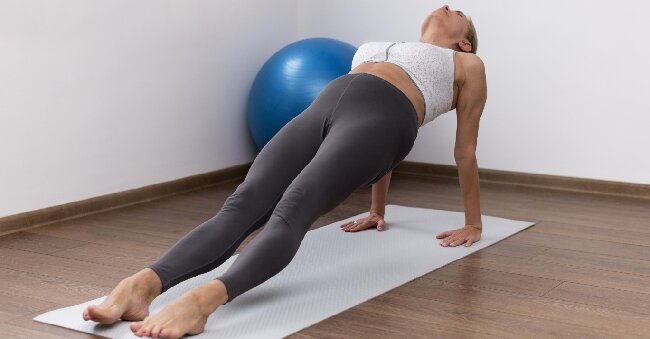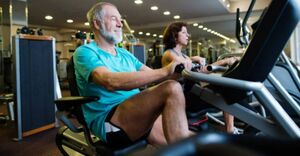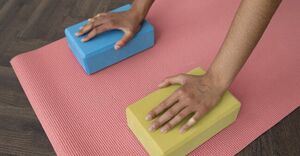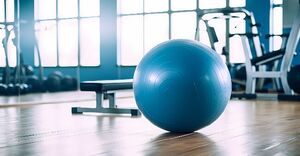
The Ultimate Fitness Ball Guide: Benefits, Exercises, and Buying Tips
For those aiming to enhance their fitness routine, the versatile fitness ball is a great option.
This comprehensive guide delves into what a fitness ball entails, the various types in the market, and the advantages of integrating one into your workouts.
Ranging from boosting balance and core strength to improving flexibility and range of motion, this uncomplicated tool offers a broad spectrum of benefits. Additionally, we will touch on typical exercises that can be carried out with a fitness ball and offer guidance on selecting the most suitable one for your requirements.
Let’s commence the journey towards a fitter, stronger version of yourself!
What Is a Fitness Ball?
A fitness ball, also referred to as a stability ball or exercise ball, is a versatile tool that can enhance workouts and contribute to overall health and wellness. Its popularity spans across individuals of varying fitness levels, offering a diverse selection of exercises targeting different muscle groups. By requiring the engagement of core muscles to stabilize oneself on the unstable surface, the fitness ball aids in strengthening the core, improving balance, and increasing flexibility. Whether one seeks to undertake advanced exercises or focus on rehabilitation routines, the fitness ball proves to be a valuable asset for home gyms or physical therapy regimens.
What Are the Different Types of Fitness Balls?
Fitness balls are available in different types, with stability balls being specially crafted to improve core strength and stability during exercise routines. Stability balls, sometimes referred to as exercise or Swiss balls, provide a flexible workout alternative that targets various muscle groups concurrently. Their unsteady surface forces the core muscles to work harder, enhancing balance and coordination.
These balls not only contribute to overall fitness but are also instrumental in rehabilitation exercises, aiding in posture improvement and alleviation of back pain. Stability balls can be utilized for stretching, strengthening exercises, and even as a supportive chair while working at a desk to promote proper posture and engage the core muscles.
What Are the Benefits of Using a Fitness Ball?
Using a fitness ball offers a multitude of benefits, from improving balance and coordination to boosting strength and flexibility, ultimately leading to enhanced overall well-being.
Incorporating a fitness ball into a workout routine can also significantly enhance posture by engaging core muscles for stability. The dynamic nature of exercises on the ball challenges various muscle groups, helping to strengthen them and prevent imbalances.
Utilizing a fitness ball can aid in reducing back pain by promoting proper spinal alignment and strengthening the back muscles. Engaging in exercises on the ball can alleviate stress through focused movements that allow for relaxation and mindfulness, potentially leading to improved circulation and better overall health.
1. Improves Balance and Coordination
One of the primary advantages of using a fitness ball is the enhancement of balance and coordination. This is achieved by the ball challenging stability and engaging multiple muscle groups simultaneously.
The instability caused by the fitness ball forces the body to make continuous minor adjustments to maintain balance. As a result, core muscles are activated and body alignment is improved. By including exercises that entail sitting, kneeling, or lying on the ball, individuals can focus on muscles in their core, legs, and arms, leading to increased overall strength and coordination. The dynamic aspect of fitness ball workouts aids in the development of proprioception, which is the body’s capacity to perceive its position in space, ultimately contributing to improved balance and coordination in everyday activities.
2. Increases Core Strength
Using a fitness ball is a beneficial method for enhancing core strength and muscle tone. The unstable surface necessitates continuous engagement of core muscles to maintain stability. This activation of core muscles while balancing on the fitness ball aids in developing and reinforcing deep muscles in the abdomen, back, and pelvis, leading to enhanced overall stability and balance.
By including exercises such as crunches, planks, and bridges on the fitness ball, you can effectively target these core muscles, resulting in a stronger core that promotes proper body alignment and posture. The dynamic aspect of exercising on the fitness ball challenges the core from various angles, leading to increased muscle activation and toning.
3. Enhances Flexibility and Range of Motion
Utilizing a fitness ball during workouts can enhance flexibility and range of motion by enabling deeper stretches and engaging a broader range of muscles.
This improved range of motion contributes to better flexibility, facilitating the performance of everyday tasks and sports movements with increased ease and efficiency. By working muscles in diverse ways, the fitness ball helps strengthen stabilizing muscles and enhance balance. Increased flexibility and muscle engagement also lower the risk of injuries during workouts or other physical activities. Overall, this results in improved performance and heightened fitness levels.
4. Can Be Used for Full Body Workouts
A fitness ball serves as a versatile tool for full-body workouts, engaging multiple muscle groups simultaneously to maximize the effectiveness of an exercise routine. These inflatable balls, also known as stability or Swiss balls, provide a dynamic platform that challenges balance and core stability with each movement.
Incorporating a fitness ball into workouts allows individuals to target various muscle groups, including the core, legs, arms, and back, leading to a more comprehensive and efficient training session. The unstable surface of the ball requires the body to engage smaller stabilizing muscles, promoting improved overall strength and coordination. This additional challenge can increase the intensity of exercises, helping with achieving greater results in less time.
What Are Some Common Exercises Using a Fitness Ball?
Various exercises can be performed using a fitness ball to target different muscle groups and enhance overall strength. Crunches on a fitness ball are effective for the abdominal muscles, with options for variations like twisting crunches to engage the obliques. Planks on the ball engage the core, back, and shoulders, with modifications available such as forearm planks for lower intensity workouts. Squats on the ball target the lower body muscles, including the quads and glutes. Push-ups on the ball work the chest, shoulders, and triceps, with incline or decline push-up variations for different intensity levels.
1. Crunches
Performing crunches on a fitness ball is an effective method for strengthening core muscles. The instability of the ball engages abdominal muscles more intensely than traditional crunches. This exercise targets deep core muscles that are often difficult to reach, improving overall core strength and stability.
To ensure proper form during crunches on a fitness ball, maintain a hip-width stance with your feet and keep your lower back pressed against the ball. It is important to focus on engaging core muscles throughout the movement rather than relying on momentum.
Incorporating a fitness ball into your crunch routine can also help improve balance, coordination, and tone your abdominals.
2. Planks
Performing planks on a fitness ball is a demanding yet highly effective exercise for enhancing core strength and stability. This exercise involves maintaining a plank position while balancing on the ball.
Engaging in planks on a fitness ball targets not only the abdominal muscles but also engages the entire core, including the obliques and lower back. Incorporating an unstable surface like a fitness ball increases the exercise’s intensity, leading to improved balance and coordination.
To ensure proper form, it is important to align your wrists under your shoulders and maintain a straight line from head to heels. Focus on engaging your core muscles throughout the exercise and remember to breathe deeply to maximize the benefits of this challenging workout.
3. Squats
Squats using a fitness ball can help enhance balance and strengthen the lower body by introducing instability that challenges muscles in different ways.
Incorporating a fitness ball into squats encourages the activation of core muscles to stabilize the body, promoting overall strength and coordination. Emphasizing proper posture and alignment during these squats can help maintain a straight back, ensure knees are aligned with toes, and distribute weight evenly. This focus on form not only reduces the risk of potential injuries but also maximizes the effectiveness of the exercise by targeting specific muscle groups.
Consistent practice and gradual intensity progression of these squats with the ball can lead to noticeable enhancements in balance and strength over time.
4. Push-Ups
Performing push-ups on a fitness ball is an effective exercise for strengthening both the upper body and core muscles. The instability of the ball requires increased stabilization and engagement of multiple muscle groups.
Executing push-ups on a fitness ball targets the chest, shoulders, and triceps while also engaging the abdominals, obliques, and lower back muscles. This compound movement contributes to enhancing overall body strength and stability.
To perform push-ups on the ball correctly, begin in a plank position with your hands on the ball shoulder-width apart. Keep your core engaged, maintain a straight line from head to heels, and lower your body by bending your arms while inhaling. Exhale as you push back up to the starting position, focusing on controlled movements for optimal muscle engagement.
How Do I Choose the Right Fitness Ball for Me?
Selecting the appropriate fitness ball requires evaluating factors such as size, weight capacity, material composition, and durability to ensure it aligns with your specific needs and preferences.
When searching for the perfect fitness ball, it is essential to take into consideration the ball’s size based on your height and intended usage. A larger ball offers increased stability for exercises like crunches and planks, while a smaller ball may be more suitable for certain movements or smaller individuals.
Weight capacity is also a critical aspect to consider to ensure the ball can adequately support your body weight during workouts. It is recommended to assess the material quality and durability, choosing anti-burst options for enhanced safety and longevity. Refer to size charts provided by manufacturers and review product specifications to make a well-informed decision.
1. Consider Your Height and Weight
When selecting a fitness ball, it is important to take into account your height and weight to choose the appropriate size that offers optimal support and stability during exercises.
Choosing the right size ensures that you can engage your core muscles effectively, enhance balance, and minimize the risk of injury. For individuals shorter than 5 feet, a 45 cm ball is advised, while those between 5’1” to 5’8” should consider a 55 cm ball. Taller individuals exceeding 5’8” may find a 65 cm ball more suitable. Weight also factors into the decision; individuals with higher body weight may necessitate a larger size for better stability. By consulting a size chart and following these guidelines, you can maximize the advantages of incorporating a fitness ball into your workout routine.
2. Check the Material and Durability
Evaluating the material composition and durability of a fitness ball is crucial to guarantee its longevity and performance, particularly for demanding exercise regimens.
Choosing a fitness ball crafted from high-quality materials not only boosts its lifespan but also contributes to your safety during workouts. Opting for sturdy materials and a non-slip surface can greatly enhance stability, enabling you to concentrate on your exercises without fretting about possible mishaps. Investing in a fitness ball with these attributes can offer peace of mind and a dependable workout tool that can endure the challenges of your fitness routine.
3. Look for Anti-Burst and Slip-Resistant Features
Choosing a fitness ball with anti-burst design and non-slip surface features can improve safety and stability during exercise sessions, reducing the likelihood of accidents or injuries.
The anti-burst design offers additional peace of mind by ensuring that the ball deflates slowly if punctured, preventing abrupt bursts that may result in falls or injuries. The non-slip surface provides grip and traction, enabling users to maintain proper form and balance while working out. By selecting a fitness ball with these important features, individuals can establish a secure workout environment that fosters confidence and comfort, ultimately enhancing their overall exercise experience.
4. Consider the Inflation Process
Understanding the inflation process of a fitness ball, including the availability of an inflation pump, is important for maintaining the desired firmness and pressure needed for different exercises. Proper inflation not only improves the overall stability of the fitness ball but also ensures its effectiveness during workouts.
An inflation pump allows for easy adjustments to achieve the optimal level of inflation for various exercises, promoting better posture, core strength, and balance. Correctly inflating the fitness ball helps prevent it from being too soft or too firm, which can affect its performance.
It is advisable to consult the manufacturer’s guidelines for specific inflation recommendations based on individual needs and exercise routines.




No Comments